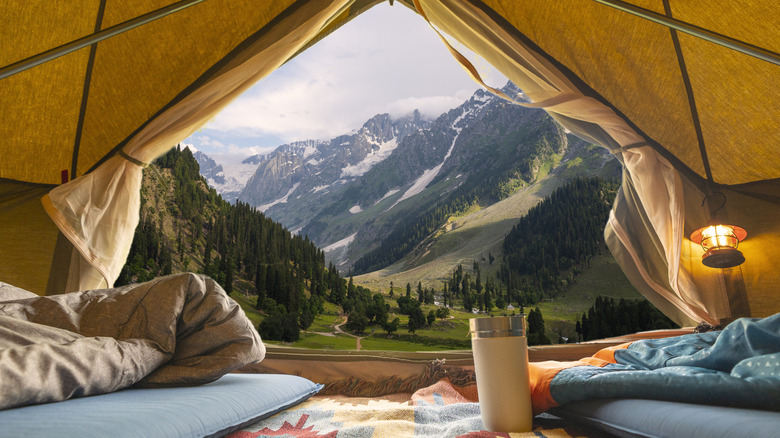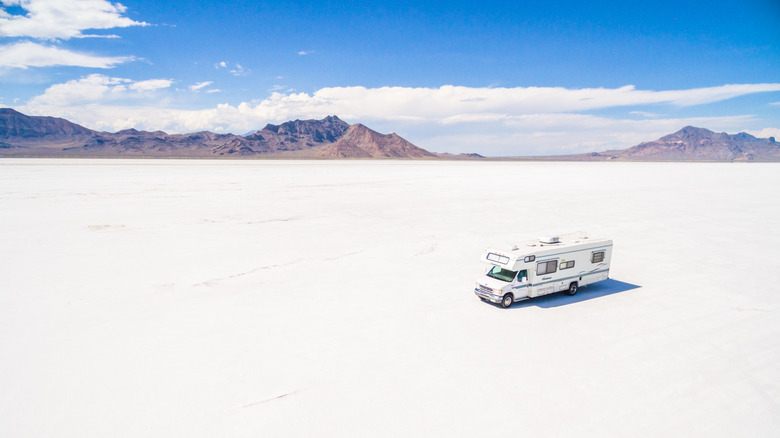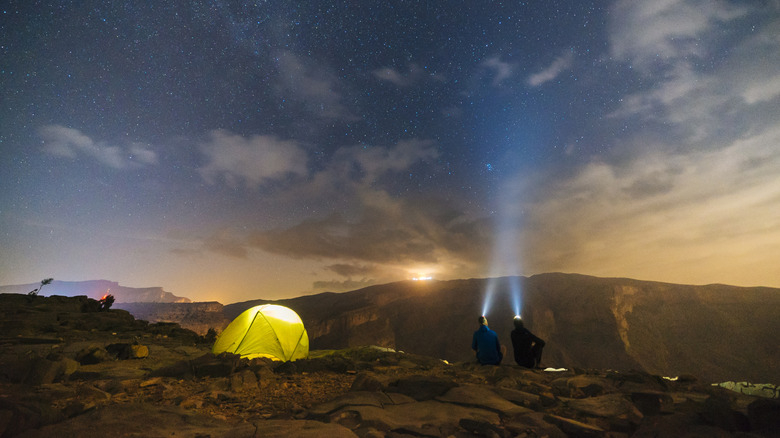Dry Camping: What It Is And Why Hikers And RVers Swear By It
Facts are facts: Fresh water doesn't care where you want to go hiking. The trail doesn't necessarily end up at a potable pond or lake. The river that flows through a national park may not be drinkable. That remote creek may look pretty, but it's possible that mine tailings or animal waste have tarnished its current. Some places, like high mountains and secluded deserts, may not have any water sources at all; even the finest filters on the market are useless when springs don't emerge and rain doesn't fall.
But hikers can be stubborn, and when the scenery is beautiful enough, nothing will deter them. One bold practice is "dry camping," when hikers sleep overnight in places that have no fresh water. Like camping out on your own, this kind of outdoor experience comes with certain challenges; an area might not have usable water, but you are still required to hydrate in order to stay healthy and, well, alive. This is especially challenging on excursions like the Kokopelli Trail, a 142-mile route through Colorado and Utah, where trekkers won't find a single dependable water source. You can still hike and camp in places like this, as long as you plan carefully ahead of time.
The joys of dry camping
Why would anyone go dry camping? Water holds a very high place in the hierarchy of needs, somewhere between oxygen and food, and most human settlement — whether a tent or a city — is built around a fresh water source. But there are lots of wonderful outdoor spaces that don't have crystal-clear ponds or accessible aquifers; even the easiest "14er" Colorado mountain peak doesn't provide fresh water beyond a certain elevation, and melting ice from glaciers or snow fields isn't always considered safe. Does this mean you should never try to reach a summit? Should you simply avoid Chile's Atacama Desert, a surreal and beautiful landscape that attracts hundreds of thousands of adventurers each year, just because it happens to be the driest place on Earth?
Of course not. About a third of the world's land area is covered in desert, and despite the definitive lack of moisture, much of this territory makes for fantastic camping and RVing. Cactus and badlands bring their own unique aesthetic, including famous attractions like Arizona's Grand Canyon and New Mexico's White Sands National Park. Without trees in the way, you could see for miles. And remember that certain ecosystems, like plains and tundra, may only have enough groundwater to support grasses, not large mammals. All of these places are worth visiting, whether on foot or in a Winnebago. Dry camping allows visitors to experience these more remote places that might not have water, but are brimming with magnificent scenery and experiences.
How to pull off dry camping
In short, if the land doesn't give you water, you have to bring water to the land. The American Hiking Society recommends that you drink at least a half-quart (and as much as a full quart) of water for every hour that you're hiking; this amount presumes comfortable temperatures and moderate exercise, but you should obviously drink more during strenuous hikes and in severe heat. You'll simply have to carry this water with you, in bottles or water bladders.
This quantity will add up quickly. Suppose you're headed on a 5-mile hike on a pleasant spring afternoon, then sleeping in a tent and returning the next morning. Five miles should take about two hours, which means up to 2 quarts of water; since you're also coming back the next day, that equals a full gallon. Then there's the time you'll spend at the campsite; if you drink a minimum recommendation of 2 cups per hour and stay there from, say, 6 p.m. to 8 a.m., you're looking at an additional 28 cups, or a gallon and a half. In total, the most rudimentary hydration on a fairly modest overnight will require 2.5 gallons of water, which will weigh in at about 20 pounds. You may be a master of packing light, but there's no way around this life-preserving weight.
Is dry camping impossible? Definitely not. Winter campers can ski or snowshoe into the wild and drag a sled behind them, which should help with the encumbrance. Cyclists can carry astonishing amounts of water on their bike frames. And car-campers can carry as much as water as they like, for days at a time; just add it to your car camping checklist.


